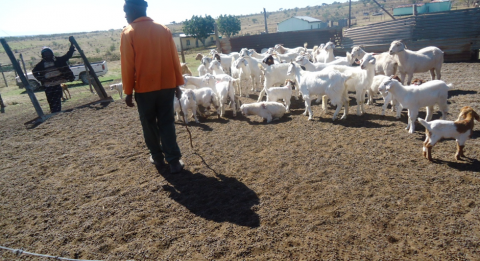
Goats play a vital role in the socio-economic lives of rural people, for instance by providing food, and quick cash by virtue of their ready market demand. However, the current performance of goats in rural areas is said to be unsatisfactory due to the high rate of kid mortality, largely by unknown causes. This level of kid mortality represents a significant barrier to increased productivity in communal goat production. Such losses impact negatively on farmers’ incomes.
A baseline investigation into the pattern of morbidity and mortality among goat kids was carried out in ten different communal farming areas around Alice town in the Eastern Cape Province of South Africa. Data from 30 randomly sampled goat flocks were used for the study. The causes of morbidity and mortality were diagnosed on the basis of clinical signs, owner’s statement, laboratory diagnosis and relevant post-mortem findings. The study revealed that from a total number of 396 kids born during April 2014 to March 2015, the overall morbidity and mortality rates were 37.1% and 25.8%, respectively. Gallsickness (10.8%), heartwater (10.8%), predation (9.8%) and coccidiosis (8.8%) were the major causes responsible for the death of kids. Death due to mixed infections was the other remarkable cause for high kids’ mortality (7.8%).
The age of the kids appears to have a strong influence on kid mortality: the study found mortality rates of 36.3%, 35.3% and 28.4% for kids aged 0-2 months, 3-4 months and 5-6 months, respectively. Season also makes a big difference: the mortality rates were 13.0%, 28.0%, 33.0% and 26.0% in post-rainy, cold-dry, hot-dry and hot-wet seasons, respectively. Moreover, higher mortality rates were recorded in male kids (36.2%) than in female kids (18.5%). The highest kids mortality rate was recorded among triplets (50.0%), closely followed by twins (46.3%).
The study revealed that kids were kept under poor housing conditions, and that very likely this contributed to the high rates of mortality. The results of this study have shown significant problems related to morbidity and mortality in goat kids raised in rural conditions.In response to the results from this baseline survey, ARDRI initiated a small community engagement intervention. Farmers were provided with some veterinary medications and extension advices. Kids born during the period were monitored for a 12-month trial. A decline in kid mortalities was observed (11.8%) and this indicates that the approach was a moderate success. However, is it scalable and affordably so? This requires further work. So does the possibility that much could gaining by blending conventional drugs with traditional treatments.